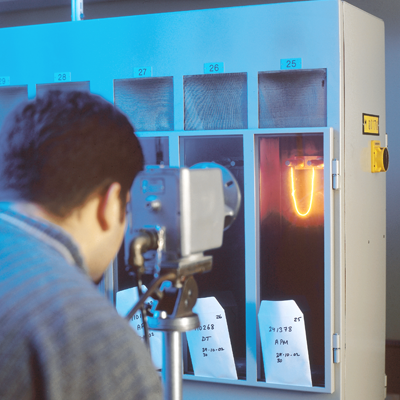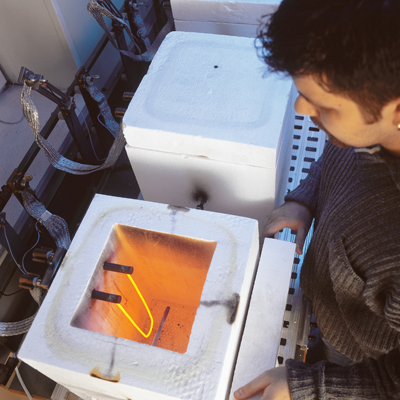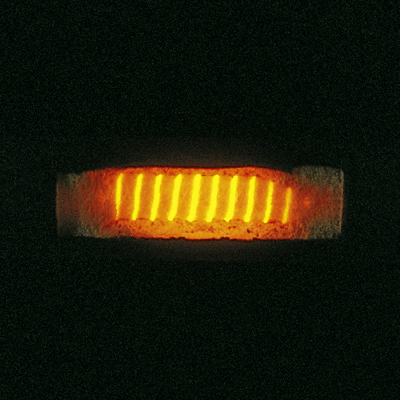Domestic applications are e.g. cooking, heating of fluids, drying, ironing, space heating and special purposes such as heating of beds, aquariums, saunas, soldering irons and paint strippers. Typical industrial applications are heat treatment, hardening and drying of inks, paints and lacquers. In vehicles, seats, engines and rear view mirrors are frequently electrically heated.
 Bash test of alloys.The appliance and the heating element must meet requirements regarding performance, cost of raw material and manufacturing, together with life and safety.
Bash test of alloys.The appliance and the heating element must meet requirements regarding performance, cost of raw material and manufacturing, together with life and safety.
The requirements may be opposed to each other. A long life and a high degree of safety means a low wire temperature, which results in a long heating up time and often also high raw material costs. Domestic heating appliances must not cause harm to individuals or damage to property. Safety specifications for each market may influence the design of the appliance and the element and limit their temperature.
The life of a well designed element depends upon the make and the type of wire used. Our FeCrAl and NiCr(Fe) wires have excellent properties at high temperature and provide the best possible life. It should be kept in mind that the life of a wire increases with wire diameter and decreasing wire temperature.
WIRE TEMPERATURE
 Life test of 4 mm wire.For embedded and supported element types the wire temperature depends upon both the wire and the element surface load. For the suspended element types the element surface load in most cases cannot be defined. In addition to the surface load, ambient temperature, heating dissipating conditions and presence and location of other elements will influence the wire temperature and therefore also the choice of wire surface load and element surface load.
Life test of 4 mm wire.For embedded and supported element types the wire temperature depends upon both the wire and the element surface load. For the suspended element types the element surface load in most cases cannot be defined. In addition to the surface load, ambient temperature, heating dissipating conditions and presence and location of other elements will influence the wire temperature and therefore also the choice of wire surface load and element surface load.
SURFACE LOAD
When calculating an element, voltage and rating are normally known. The surface load for the heating element means the rating divided by element surface area of the energized wire. Usually a range of surface loads and not one single figure is listed in the mentioned tables. The choice within the range depends upon the requirements for the element. It also depends upon voltage, rating and dimensions available. A high voltage and a low rating will result in a thin wire, which at the same temperature has a shorter life than a thick wire and will therefore require a low wire surface load.
The wire surface is then found as the ratio between rating and wire surface load.
SURFACE AND RESISTANCE
After having calculated the resistance in cold state, the ratio between the surface and the resistance is found. This ratio is listed for all wire types and wire dimensions in the handbook for ‘Resistance heating alloys and systems for industrial furnaces’, and the correct wire size can therefore easily be found from these tables.
COIL PARAMETERS
The ratio between coil and wire diameter (D/d) must be calculated in order to check that the coil can easily be manufactured. Recommended ratio (D/d) should be in the range of 5–12. In case of supported elements, this ratio must be compared with the deformation curve at page 17. When the coil length and diameter are known, the coil pitch (s) can be estimated by formula [17] in the Appendix. Coil pitch (s) is normally 2–4 times the wire diameter (d). For quartz tube heaters a smaller pitch is normally used. Preoxidized coils made from Kanthal® FeCrAl in such elements can be used tightly wound.
For a straight wire on a threaded ceramic rod and for many elements of the suspended type the wire length is fixed. The resistance per meter can then be calculated and the wire size found from the tables of the handbook for ‘Resistance heating alloys and systems for industrial furnaces’. If this results in too high a surface load in case of a ribbon, a wider and thinner ribbon having the same cross-section can be chosen.
METAL SHEATHED TUBULAR ELEMENT
 Glowing coil inside tubular heating elements.The calculation of a metal sheathed tubular element is more complicated since the resistance is reduced 10 to 30% as a result of the compression of the element. For such elements, the tube surface load is first determined according to the use of the element. The wire surface load is normally 2 to 4 times greater. After calculating the resistance from rating and voltage, it has to be increased 10 to 30% in order to get the resistance after coiling. The wire surface will become 2 to 7% smaller when the element has been reduced. Since the tube length is increased through compression by rolling, the tube surface often remains unaltered.
Glowing coil inside tubular heating elements.The calculation of a metal sheathed tubular element is more complicated since the resistance is reduced 10 to 30% as a result of the compression of the element. For such elements, the tube surface load is first determined according to the use of the element. The wire surface load is normally 2 to 4 times greater. After calculating the resistance from rating and voltage, it has to be increased 10 to 30% in order to get the resistance after coiling. The wire surface will become 2 to 7% smaller when the element has been reduced. Since the tube length is increased through compression by rolling, the tube surface often remains unaltered.
Design calculations for heating elements: examples (PDF document, 103 kB)